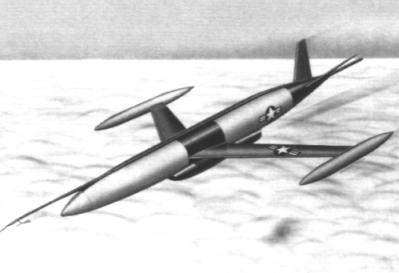Convair MX-2223 (SM-74)
In late 1952, the U.S. Air Force planned to develop a ground-launched long-range decoy missile to simulate B-36, B-47, B-52 and B-58 strategic bombers on radar. Study contracts were eventually awarded to Fairchild and Convair in July 1954 under project MX-2223. Convair came up with a swept-wing, vee-tail design with a fuselage partially made of non-metallic composites. Radar reflectors in the fuselage and wing-tip pods would augment the radar return for realistic simulation of the larger bombers. However, Convair's MX-2223 design was not further developed, because in December 1955, the USAF awarded only Fairchild a follow-on contract to develop the SM-73 Bull Goose decoy missile.
 |
| Image: Convair |
| Convair MX-2223 (XSM-74) |
The Convair MX-2223 missile was to be designated XSM-74, but the designation was apparently not finally approved (probably because the missile's development was cancelled). Therefore the M-74 slot in the USAF's guided missile series was never assigned to any flying vehicle.
Specifications
Note: Only approximate data are available!
Data for Convair MX-2223 (XSM-74):
| Length | 9 m (30 ft) |
| Wingspan | 6-7.5 m (20-25 ft) |
| Weight | 2300-3400 kg (5000-7500 lb) |
| Speed | Mach 0.8-0.9 |
| Ceiling | 10000-15000 m (35000-50000 ft) |
| Propulsion | Turbojet |
Main Sources
[1] Dennis R. Jenkins: "Magnesium Overcast: The Story of the Convair B-36", Specialty Press, 2001
[2] USAF Missile Nomenclature Records
Back to Directory of U.S. Military Rockets and Missiles, Appendix 1
Last Updated: 3 July 2007